Are you looking for the best exercises to build bigger and stronger back muscles? We have everything you need. Thoroughly read to gain insight into the most effective exercises for enhancing your back size and strength.
When it comes to back muscles, the focus is usually all about the lats. However, if you want a well-rounded, strong, and good-looking back, you can’t forget to train traps, rear delts, rhomboids and erector spinae.
If you neglect and fail to strengthen them alongside the other muscles in your back, it can lead to poor posture, decreased performance, and even injury down the line.
Strengthening your complete back is absolutely necessary for achieving the best possible physique and fitness level.
In this article, you will learn
- How to train your back effectively for growth
- Best back exercises for mass and strength
- Back Workout Training Techniques
- Back workout plan
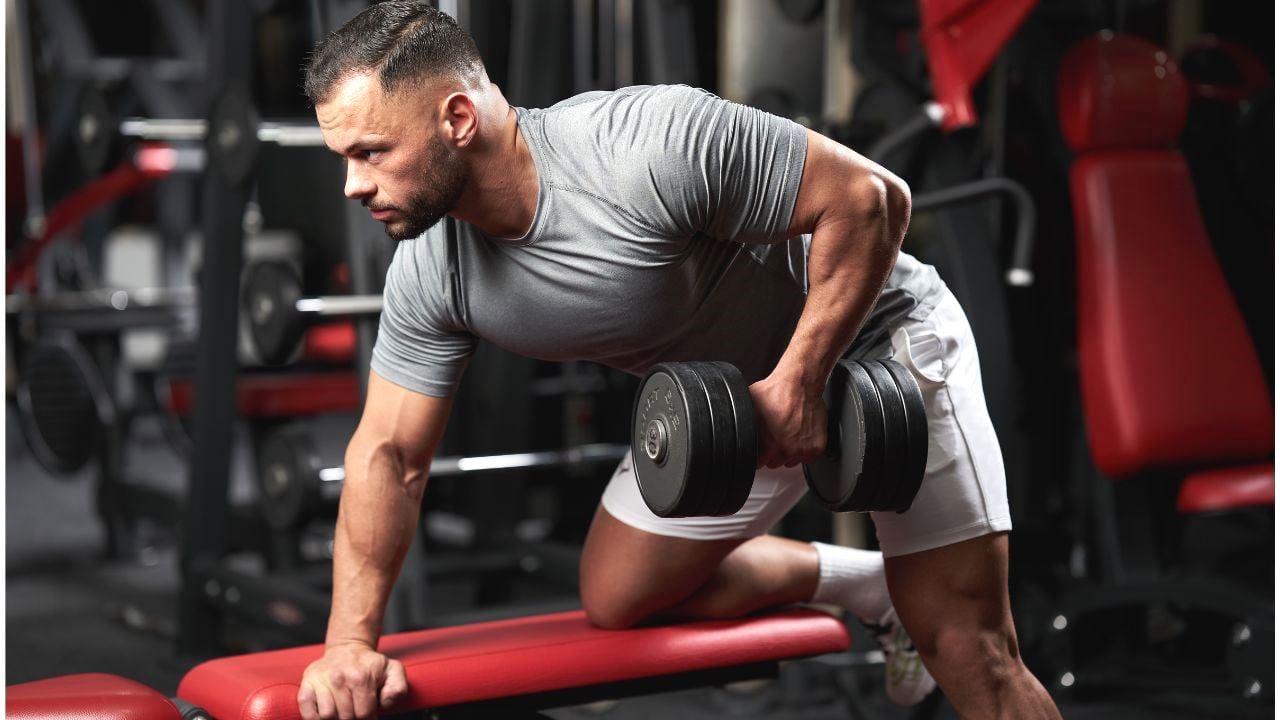
- How To Train Back To Build Muscles Mass and Strength
- 12 Best Back Exercises For Mass and Strength
- 1. Lat Pulldown
- 2. One Arm Dumbbell Rows
- 3. Pull-Up
- 4. Straight Arm Lat Pulldown
- 5. Deadlift
- 6. Bent Over Barbell Rows
- 7. Back Extension
- 8. Seated Cable Rows
- 9. T Bar Rows
- 10. Dumbbell Pullover
- 11. Barbell Upright Row
- 12. Barbell Shrug
- Complete Back Workout To Build Mass
- Back Training Plan With Workout Routines
- Know About Back Muscle
- FAQ About Back Training
- Conclusion
- References
How To Train Back To Build Muscles Mass and Strength
Training the muscles of the back is a complicated endeavor. Many exercises are designed to address this different region of the back.
Most of the back exercises are pulling exercises, meaning they involve pulling a weight towards you in either a horizontal (think barbell and dumbbell rows) or vertical (think pull-ups and lat pull-downs) movement plane.
Some exercises, like deadlifts and back extensions, primarily focus on the lower back, multitudes, and erector spinae.
The options seem endless, from lat pull-down and back extension machines to pull-up bars and free weights. Of course, there is a good reason for this, as the back muscles vary tremendously in terms of their functions and angles of contraction.
Some people prefer to perform back exercises for strength and pain-free life, while others are more interested in back workouts for building muscle. You can for both.
Again, the different training goals will mostly affect the number of reps, sets, and weights performed for the back workouts.
- When you are doing back workouts to increase strength, aim to do 2-6 sets of 3-5 reps per exercise, using at least 85% of your one-repetition maximum (1RM)
- For a hypertrophy (muscle growth) back workout, try to perform 3-4 sets of each barbell exercise using loads that are 70 to 85% of your 1RM for 8 to 12 reps.
For complete back development, you must train all the back muscles using different gym equipment, exercises, sets, and rep ranges, and sets.
12 Best Back Exercises For Mass and Strength
The back exercises are divided into barbell rowing, dumbbell rowing, pullover, cable and machine and body-weight exercises.
- Lat Pulldown
- One Arm Dumbbell Rows
- Pull-Up
- Straight Arm Lat Pulldown
- Barbell Upright Row
- Deadlift
- Bent Over Barbell Rows
- Lumbar Hyperextension
- Seated Cable Rows
- T Bar Rows
- Dumbbell Pullover
- Barbell Shrug
1. Lat Pulldown
The Lat pulldown is a popular gym exercise that targets and strengthens upper back muscles, particularly the latissimus dorsi. The exercise also engages other muscles, including the biceps, trapezius, and shoulders, to some extent.
The exercise is easy to learn and very effective at building back strength.
This exercise can be performed using wide or narrow grips, pulling to the front or back. The wider grip is the best variation for targeting the outer lats.
Lat pulldown variations for back growth:
- Wide grip pulldown
- Reverse grip lat pulldown
- V Bar pulldown
- Rope handle pulldown
- Single arm lat pulldown
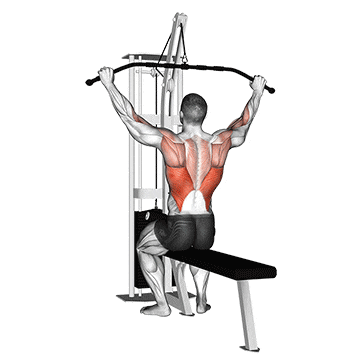
How To Do It
- Take an overhand grip, hands slightly wider than shoulder-width apart, and sit on the machine seat.
- Lock your knees under the support pads.
- Keep your upper back straight, pull the bar down and bring it up to your chest.
- As you pull down, squeeze your shoulder blades together and feel your back muscles contracting.
- Perform this movement using your upper lats, using the arms merely as a lever between the bar and the lats.
- Now, release the bar with controlled motion and stretch your lats as much as possible.
- Your reps should be slow and controlled to make the most of this move.
Related Post: 20 Best Cable Back Exercises For Wider And Strong Back
2. One Arm Dumbbell Rows
One-arm dumbbell rows are an excellent alternative to barbell rows. It is a compound exercise that primarily targets the back muscles, including the lats, rhomboids, and trapezius.
This helps to work on each side independently, thereby providing better muscle isolation and a longer range of motion. And greater hypertrophy.
One-arm dumbbell row variations for back growth:
- One arm row with one hand on a rack and both leg on the floor
- One arm row with one hand and one leg on a bench
- Single-arm landmine row
- Single arm meadows row
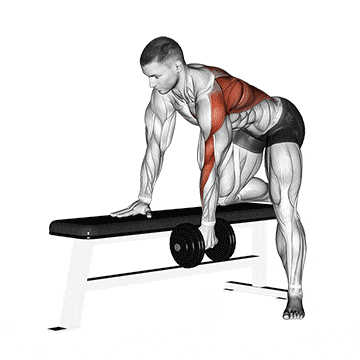
How To Do It
- Grasp a dumbbell with the palm facing in. Rest the opposite hand and knee on a bench, keeping your spine straight and just above parallel to the floor.
- Pull the dumbbell vertically upward alongside your torso, raising the elbow as high as possible.
- Slowly lower the dumbbell as low as possible, feeling a good lats spread.
- Keep motion under strict control for better isolation.
- Repeat on the other side.
Know More: 10 Best Barbell Back Exercises For Strength And Mass
3. Pull-Up
The pull-up is an upper-body strength movement that targets the back, shoulders, and arms. It is often a challenge for beginners and even experienced athletes. This bodyweight exercise can induce serious muscle growth in the back and biceps.
The pull-up is harder to perform than a standard pull-up because your hands will be further away from the center of your body.
The pull-up increases the strength, thickness, and width of your back, specifically your lats. The lats influence back width and form the “V” in the upper back.
There are many variations of pull-ups that can be done to target the back:
- Wide grip pull-ups (overhand grip)
- Chin-ups (underhand grip)
- Neutral grip pull-ups (palms facing inward)
- Weighted pull-ups
- Machine assisted pull-ups
- Spotter assisted pull-ups
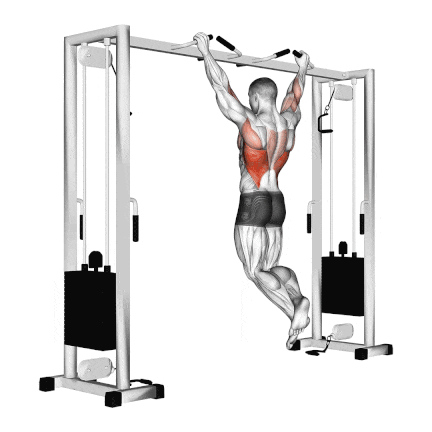
How To Do It
- Using an overhand grip, grab on to a pull-up bar with your hands spaced wider than shoulder-width apart.
- Hang from the bar with your arms fully extended and your chest high, while exaggerating the arch in your lower back.
- Pull yourself up by squeezing your shoulder blades together and contracting your lats until your chin passes the bar.
- Hold the contraction at the top for a second before slowly lowering yourself back to the starting position.
- Go with the full range of motion and keep the form correct. Avoid jerky movements and keep them controlled.
4. Straight Arm Lat Pulldown
The straight arm pulldown is one of the best exercises for strengthening your lats. This isolation exercise can also help improve your posture and build a stronger back.
The straight-arm pulldown trains the lats through a long range of motion. It’s helpful for people who have trouble feeling their backs work on conventional pulldown exercises.
While the exercise will primarily target the lats, you will also notice a fair amount of bicep and middle back activation.
Straight Arm Lat Pull Down variations for back growth:
- Wide grip Straight Arm Lat Pulldown
- Close grip Straight Arm Lat Pulldown
- Rope Straight Arm Lat Pulldown
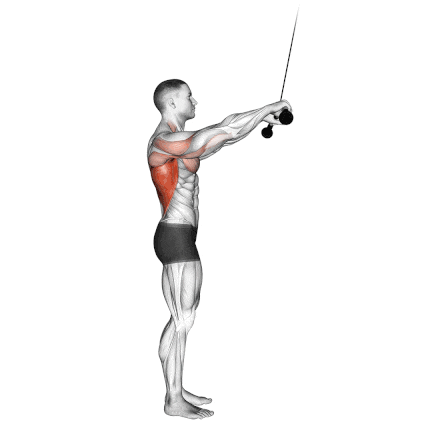
How To Do It
- Take an overhand grip wider than shoulder-width on a lat bar attached to the pulley on the lat pulldown bar.
- Position yourself with your feet flat on the floor, chest up, and low-back arch exaggerated.
- Pull your shoulder blades together as you squeeze your lats to initiate the movement, pulling the bar down smoothly to your midsection.
- Hold the contraction momentarily, then slowly return the bar to its starting position.
5. Deadlift
The deadlift is the King of all exercises. This power exercise is designed to build an overall physique that utilizes more muscles than any other exercise. The deadlift is the best exercise for posterior chain muscle strengthening. It works on your whole body, including the lower back, upper back, arms, legs, and buttocks.
It is the biggest muscle builder, recruiting more muscle motor units than any other exercise. This exercise can be performed using either a barbell or a pair of dumbbells.
You can go real heavy on a barbell deadlift, but do this exercise with caution and technique.
Deadlift variations for back growth:
- Dumbbell Deadlift
- Cable Deadlift
- Barbell rack pull
- Romanian deadlift
- One Leg Dumbbell Romanian Deadlifts
- Landmine Deadlift

How To Do It
- Place a barbell loaded in front of you.
- Use an underhanded grip with one hand and an overhand grip with the other hand to grab the barbell.
- Remember to keep your back as straight as possible and contract your back and hamstrings.
- Now raise the bar from the ground using your hamstrings and glutes.
- You should keep your legs slightly bent, your back straight, and your head looking up. Your heels, not toes or elbows, should provide the initial movement.
- Raise it to the point where your body is erect. Do not hyperextend your body as the weight shifts to the lumbar spine.
- Hold the bar momentarily at the top of the lift.
- Now lower the bar slowly at a steady slow pace by bending at the hips first and then at the knees and let the weight touch the ground for a moment before you begin the next rep
- If you’re going heavy (sets of fewer than about 6 reps), do deadlifts first, so you’re fresh. If you’re doing for repetitions, you can do them later in your workout.
6. Bent Over Barbell Rows
If you want to strengthen your entire back—upper back, lower back, lats, traps, and spinal erectors—bent-over barbell rows are the best exercise. The science backs it up.
Spacing your hands shoulder-width apart or closer targets the central inner section of the lats, whereas a wider grip targets the outer lats.
Pulling the bar up higher toward the chest targets the upper latissimus and trapezius. Pulling the bar through a lower trajectory to touch the abdomen targets the lower lats.
Bent-over row variations for back growth:
- Overhand grip bent-over rows
- Underhand grip bent-over rows
- Pendlay rows
- Dumbbell Bent Over Dumbbell Row
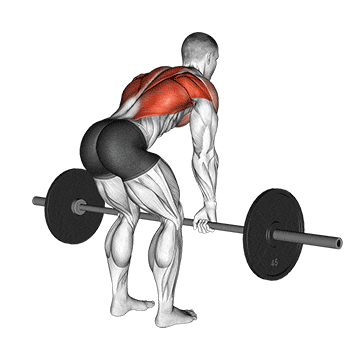
How To Do It
- Stand with a narrow stance and grab a bar with an overhand grip.
- Bend your torso forward at an angle of 45 degrees to the floor with the knees slightly, and let the bar hang in front of you.
- Now use the back and raise the bar until it touches the abdominal region and not the chest region, as it reduces back muscle contraction.
- Slowly lower the bar under control to the starting position.
- Do not use more weight than you can handle. This fatigues your spinal erectors and says goodbye to form.
- Exhale on pushing movement, and inhale when returning to the starting position.
7. Back Extension
The hyperextension exercise, also known as a back extension, is a fundamental movement that targets the muscles of your posterior chain, primarily your lower back (erector spinae) and glutes.
You can use a dedicated hyperextension bench or a Roman chair. If neither is available, you can modify the exercise by lying face down on the floor or a stability ball.
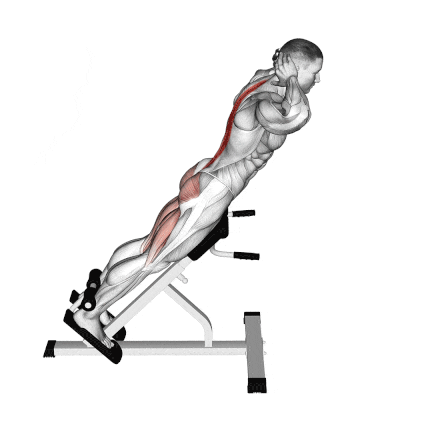
How To Do It
- Adjust the pad height so the top of your hips rests comfortably on the pad.
- Lie face down on a Hyperextension bench and hook your legs under support. Your body should be parallel to the ground.
- Place your hands on your chest (or behind your neck) and bend down through your waist until you reach a 90-degree bend.
- Keep your back straight and avoid rounding your spine.
- Return to the start position, but avoid extending beyond the body level.
- Do the desired number of reps and sets.
8. Seated Cable Rows
Seated cable rows are an excellent exercise for building middle back muscles, which also works on lower lats. It can be done with wide and narrow grips.
In contrast to other free-weight variations, the classic seated row maintains constant tension throughout the movement.
The cable row training offers almost unmatched versatility because you can easily change up the load, angle, grip positioning, and body positioning.
This back exercise is done on a cable rowing machine with separate handles, a grip position change, and muscle work involved.
- A pronated (overhand) grip targets the upper and middle trapezius.
- A neutral (thumbs up) grip hits the middle and lower trapezius.
- The supinated (underhand) grip switches the focus to the latissimus dorsi.
Different attachments can be used for back growth.
- Wide Grip Seated Row
- Single-arm row
- Rope attachment
- Long bar….. Get creative!
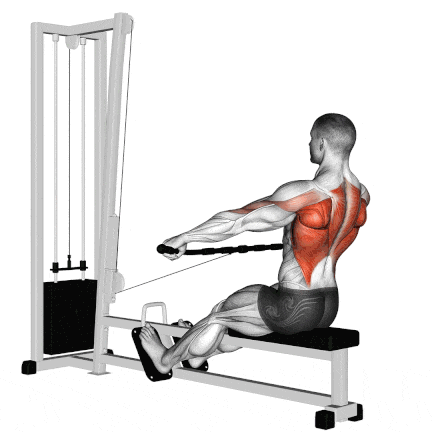
How To Do It
- Sit on a seated cable pulley rowing machine and feet supported against the crossbar.
- Keep your knees slightly bent to avoid knee and lower back pressure.
- Take hold of the handles with your arms extended and back stretched.
- Keep your upper back stationary, don’t move your upper back, back, and forth.
- Pull the handles so that they come as close to the lower chest/abdomen as possible.
- Pause briefly when the handles are close to the chest and squeeze your upper back muscles, bringing the scapulae closer.
- Thrust your chest out while pulling with your body in an upright position. Slowly return the handle to the starting position.
9. T Bar Rows
T-bar Row is a power exercise for building middle back muscles. Check the correct execution technique and blast your back muscles. When done with a narrower grip, it also works on the outer lats.
It is done on a T-bar machine or by placing a barbell in the corner. T-bar rows are a tough exercise, but building a strong back is a must to develop a quality physique, stay injury-free, and be pain-free for life.
The chest-supported row exercise is similar to the T bar row and allows you to concentrate on working most muscles on the upper body’s posterior side.
This row variation requires less effort to keep your body stable because one end of the bar pivots at a fixed point on the floor, and the chest is supported on the bench.
Chest-supported row variations to grow the bigger and stronger back:
- Dumbbell Chest Supported Row (Underhand, Overhand, Single hand and Neutral grip)
- Barbell Chest Supported Row (Underhand, Overhand)
- Chest Supported Row with Cables. (Underhand, Overhand, Single hand and Neutral grip)
- Machine Chest Supported Row. (Underhand, Overhand and single Arm)
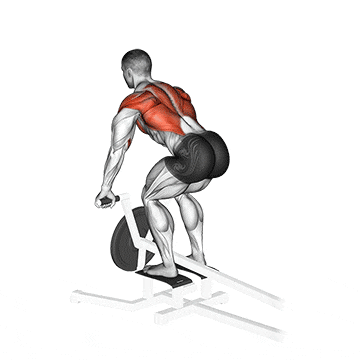
How To Do It
- Standing on a T-bar machine, grab its handles with an overhand grip.
- Keep your feet a bit apart and knees slightly bent.
- Bend at the hips and keep your back arched throughout the movement.
- Lift the bar until the bar touches your chest, keeping the back straight.
- Now, slowly lower the bar until it nearly touches the ground.
- Go Complete range of motion.
10. Dumbbell Pullover
A Dumbbell Pullover is the best exercise to build a strong rib cage and build serratus anterior muscle to build a complete chest and back.
Pullover works directly on the serratus anterior muscle to develop the back. This exercise is done lying across a bench with a heavy dumbbell.
The best pullover exercise variations to train your back.
- Flat bench pull-over (dumbbell, barbell, weight plate)
- Incline pull-over (dumbbell, barbell, weight plate)
- Decline pull-over (dumbbell, barbell, weight plate)
- Cable pull-over

How To Do It
- Lie across on a bench on your shoulders so that your head is hanging.
- Grasp a dumbbell with both hands and get it straight over your chest.
- Lower the dumbbell in an arc slowly, getting a good stretch in your rib cage.
- Lower the dumbbell as far as possible and then raise it back to the starting position.
11. Barbell Upright Row
Upright Barbell Row is an excellent exercise for building huge Trapezius muscles and creating delto-pectoral separation.
Do Upright Row along with shrugs to build massive traps. You can use a Smith machine, free weights, or cable to perform upright rows.
The upright row can be done with normal, narrow, or wider grips.
- The normal grip upright row provides overall shoulder development and suits those seeking balanced muscle activation.
- The narrow grip upright rows places emphasis more on the upper trap and a little lesser on the lateral delt and rear delt.
- The wide-grip upright row places heavy emphasis more in the lateral and rear deltoid and little lessor on the upper and middle trap
Upright Row variations for back growth:
- Dumbbell Upright Row
- Upright Cable Row
- Kettlebell Upright Row
- Rope Upright Row
- Ez Bar Upright Row
- Smith Machine Upright Row
- Single Arm Upright Row
- Resistance Band Upright Row
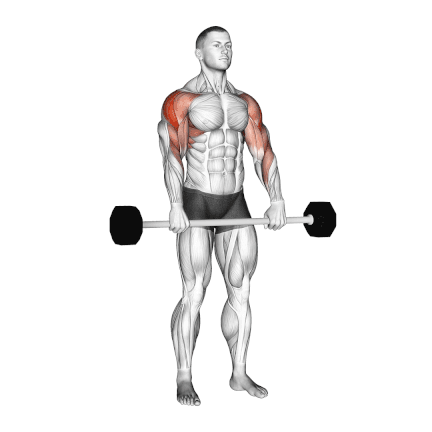
How To Do It
- Hold a bar with a narrow overhand grip and let it hang in front of you.
- Lift the bar and bring it close to your chin. Focus on keeping your elbows higher than your forearms
- Now lower the bar under controlled motion until it comes back to its starting position.
- Repeat for desired reps.
- Keep a controlled motion and avoid jerky movements.
12. Barbell Shrug
The Barbell shrug is one of the best exercises for building bigger, stronger trapezius muscles. This exercise can be done extremely heavily to thicken the traps, which really helps in doing back poses.
You can do the shrug using a dumbbell, barbell, or Smith machine. However, the barbell variation is the classic variation for building massive traps.
Traps, being a stubborn muscle group for many, can be trained fairly frequently during the week.
For upper back growth and to increase the variety of your shrug exercise, you could try to :
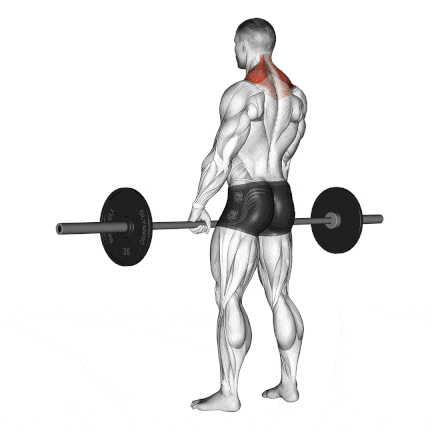
How To Do It
- Stand with feet placed shoulder-width apart, knee slightly bent, and core stable.
- Grip the barbell with your hands facing you.
- Raise your shoulders without bending the elbows as far as possible, getting them closer to your ears.
- Hold the contraction and squeeze for a brief second. Then, in a controlled and stable manner, lower the weight back down to the starting position.
- Go as high as possible, but limit momentum and excessive jerking or bouncing of the weight.
Complete Back Workout To Build Mass
Effective back training should incorporate various exercises and target all the major back muscles.
For a complete back workout and to build balanced strength, you’ll need to do a variety of back exercises that specifically target your upper, middle, and lower back muscles.
- Upper and middle back exercises target the trapezius and lats.
- When choosing exercises for your upper back, you should include a variety of high-pulling exercises, such as rows and straight arm lat pull-down.
- The lower back is to be targeted with exercises like deadlift and seated cable rows.
- This training routine for the back is designed to increase strength and muscle mass. However, the gains will be increased with the use of primary lifts like deadlift, Bent-Over Row.
Back Training Plan With Workout Routines
Of course, the number of sets and reps will be determined based on your fitness journey, but here is a great starting point:
Weekly Back Workout Sets
- Beginners: ~10 sets per week.
- Intermediate: ~15 sets per week.
- Advanced: ~20 sets per week.
When a certain amount of volume stops being effective and your progress stalls, you can add sets to increase volume and use that as a driver of renewed progress.
Reps Range for Back Training for Specific Goals
- For muscle endurance: Aim for 3–4 sets of 12–15 reps, with moderate resistance.
- For muscle strength: Aim for 3–5 sets of 6–10 reps, with a heavier amount of resistance.
- For muscle hypertrophy (increased muscle size): Aim for 3–4 sets of 8–12 reps, with a moderate to heavy resistance.
It is always best to start with a lower number of reps and sets, and then gradually increase as your strength improves. Furthermore, it is important to allow for adequate rest between sets, typically 60–90 seconds.
Strength, Power, Hypertrophy and Endurance table of Mell Siff’s Supertraining
| Variable | Strength | Power | Hypertrophy | Endurance |
|---|---|---|---|---|
| Load (% of 1RM) | 80-90 | 45-55 | 60-80 | 40-60 |
| Reps per set | 1-5 | 1-5 | 6-12 | 15-60 |
| Sets per exercise | 4-7 | 3-5 | 4-8 | 2-4 |
| Rest between sets (mins) | 2-6 | 2-6 | 2-5 | 1-2 |
| Duration (seconds per set) | 5-10 | 4-8 | 20-60 | 80-150 |
| Speed per rep (% of max) | 60-100 | 90-100 | 60-90 | 60-80 |
| Training sessions per week | 3-6 | 3-6 | 5-7 | 8-14 |
Beginner Back Workout Plan
If you’re new to lifting weights, don’t worry. This beginner-friendly back workout routine is a great place to start.
When this becomes easier, you should pick a heavier weight.
| Exercise | Sets | Reps | Rest |
|---|---|---|---|
| Pull Ups | 4 | 8-10 | 60-90 sec |
| Seated Cable Row | 4 | 10-15 | 60-90 sec |
| Bent Over Dumbbell Rows | 3 | 15-10 | 60-90 sec |
Intermediate Back Workout
If you are an intermediate level or have outgrown the beginner routine, try the intermediate back workout routine below.
| Exercise | Sets | Reps | Rest |
|---|---|---|---|
| Deadlift | 4 | 6-8 | 90-120 sec |
| One Arm Dumbbell Rows | 3 | 8-10 | 60-90 sec |
| Lat Pull Down | 4 | 10-12 | 60-90 sec |
| Dumbbell Pullover | 3 | 8-10 | 60-90 sec |
Advanced Back Workout
Try the advanced routine if you are an advanced-level athlete or have already completed the beginner and intermediate back workouts.
Here, you’ll challenge your balance, stability, and strength more.
| Exercise | Sets | Reps | Rest |
|---|---|---|---|
| Barbell Deadlift | 3 | 8-12 | 90-120 sec |
| Barbell Bent Over Row | 4 | 6-8 | 60-90 sec |
| T Bar Rows | 4 | 8-10 | 60-90 sec |
| Barbell Upright Row | 3 | 10-12 | 60-90 sec |
Know About Back Muscle
To build a strong and muscular back, you must first understand the anatomy and functionality of the back muscles. Your back muscles start just under your skull and down to your lower back, just above your hips. These muscles connect to your ribs, vertebrae, shoulder blades, and neck.
Your back is made up of three groups of muscles. They are:
Superficial Muscles
These muscles are closer to the surface of the skin and make up the upper and lower back muscles. Includes:
- Latissimus dorsi (lats): Commonly referred to as the “lats,” large muscles that extend from the middle and lower back to the armpits
- Rhomboids: Located between the shoulder blades. They run from the medial border of the scapula (shoulder blade) to the spine.
- Trapezius (traps): Large, triangular muscle that extends from the base of the skull down to the mid-back.
- Levator scapulae: Located on the side and back of the neck. It runs from the upper cervical vertebrae to the upper border of the scapula (shoulder blade)
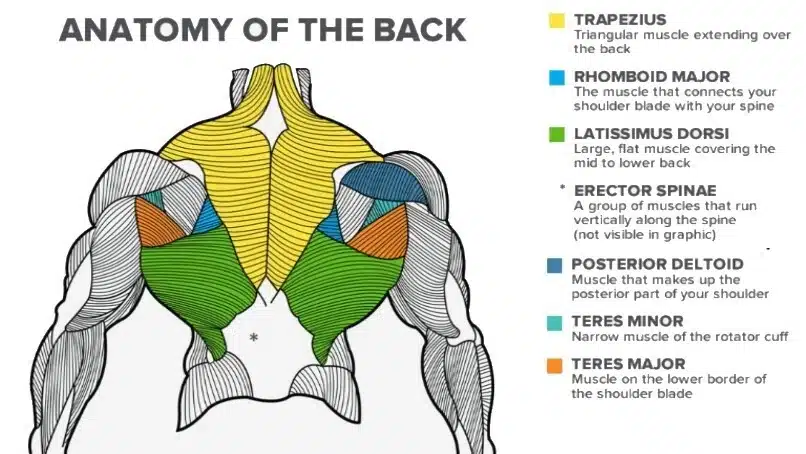
Intermediate Muscles
This group comprises the serratus posterior inferior and serratus posterior superior, which are situated in the shoulder girdle, between the shoulder blades.
Intrinsic Muscles
Found deep beneath the skin, the intrinsic muscles consist of two groups:
- Erector spinae: The erector spinae is a group of muscles that run alongside the spine
- Transversospinalis: They consist of several smaller muscles that run obliquely, crossing multiple vertebral levels.
FAQ About Back Training
To conclude, let’s go over some frequently asked questions about training your back
What is the king of all back exercises?
The deadlift is the king of all back exercises. It is a compound movement that targets multiple muscles in the back, including the erector spinae, latissimus dorsi, and trapezius. Deadlifts are highly effective for building overall back strength, improving posture, and improving functional fitness.
Can I do back exercises everyday?
No, it is generally not recommended to perform back exercises every day. Like any muscle group, the back muscles need time to recover and grow. Allow at least 48 hours of recovery time between intense back workouts.
How To Train Upper, Middle and Lower Back
As you saw above, many exercises engage both primary and secondary muscles.
We will need to hit all areas to build an all-around strong back.
- For the lower back, you can do exercises like deadlifts to strengthen the posterior chain.
- For middle back, focus on exercises where your hands are closer together, like close-grip rows.
- The upper back, can be done with exercises like Pull-ups, single-arm bent over rows and upright row.
- The Trap muscles can be done with exercises like shrug and upright row.
Conclusion
This exercise is highly recommended for anyone interested in building back strength and gaining muscle size.
It allows for targeted muscle development and provides an overall upper-body workout.
Be smart: Don’t limit yourself to one type of equipment for back training. Use different equipment to get the benefits of a full back workout.
- Cable Back Exercises
- Barbell Back Exercises
- Dumbbell Back Exercises And Workout
- Bodyweight Back exercises
If you do these back exercises consistently, the results will speak for themselves.
Thanks for reading, and enjoy working on your Back Workout!
References
- Schoenfeld, Brad MSc, CSCS; Kolber, Morey J PT, PhD, CSCS; Haimes, Jonathan E BS, CSCS: The Upright Row: Implications for Preventing Subacromial Impingement. Strength and Conditioning Journal: October 2011 – Volume 33 – Issue 5 – p 25-28
- Cools AM, Witvrouw EE, Declercq GA, Danneels LA, Cambier DC. Scapular muscle recruitment patterns: Trapezius muscle latency with and without impingement symptoms. Am J Sports Med 31: 542–549, 2003.
- Int J Environ Res Public Health. Trapezius muscle timing during selected shoulder rehabilitation exercises. 2021 Jun 14;18(12):6444. doi: 10.3390/ijerph18126444.PMID: 34198674
- Lorenzetti S, Dayer R, Pluss M, List R. Pulling exercises for strength training and rehabilitation: movements and loading conditions. J Funct Morphol Kinesiol. 2017;2(3):33. doi:10.3390/jfmk2030033
- Chad M J Fenwick, Stephen H M Brown, Stuart M McGill. Comparison of different rowing exercises: trunk muscle activation and lumbar spine motion, load, and stiffness. PMID: 19620925 DOI: 10.1519/JSC.0b013e3181b07334
- Jett, David Michael Jr. M.S., C.S.C.S., EP-C, PN; Gibb, Jessica M.S., CEP, EP-C, FMSC; Verrill, David E. M.S., RCEP, CEP, PD, FAACVPR. Evidence-based Alternatives To Popular Exercises. ACSM’s Health & Fitness Journal: November/December 2017 – Volume 21 – Issue 6 – p 20-26

Manish is a NASM-certified fitness and nutrition coach with over 10 years of experience in weight lifting and fat loss fitness coaching. He specializes in gym-based training and has a lot of knowledge about exercise, lifting technique, biomechanics, and more.
Through “Fit Life Regime,” he generously shares the insights he’s gained over a decade in the field. His goal is to equip others with the knowledge to start their own fitness journey.
